We must exercise every ingenuity
to reconcile differences by simple, friendly human contacts away
from protocol, diplomacy and debates over ideologies which are
the functions of the chancelleries and the United Nations. This
is our opportunity at Flushing Meadow in 1964 and 1965.
- Robert Moses101
MURAL OF A REFUGEE*

|
- Before you
go,
- Have you
a minute to spare,
- To hear a
word on Palestine
- And perhaps
to help us right a wrong?
-
- Ever since
the birth of Christ
- And later
with the coming of Mohammed,
- Christians,
Jews and Moslems, believers
- .....in one God,
- Lived there
in peaceful harmony.
-
- For centuries
it was so,
- Until strangers
from abroad,
- Professing
one thing, but underneath,
- .....another,
- Began buying
up land and stirring up the
- .....people.
-
- Neighbors
became enemies
- And fought
against each other,
- The strangers,
once thought terror's victims,
- Became terror's
fierce practioners.
-
- Seeking peace
at all costs, including the
- .....cost of justice,
- The blinded
world, in solemn council, split
- .....the land in two,
|
- Tossing to
one side
- The right
of self-determination.
-
- What followed
then perhaps you know.
- Seeking to
redress the wrong, our nearby
- .....neighbors
- Tried to
help us in our cause,
- And for reasons,
not in their control, did not
- .....succeed.
-
- Today, there
are a million of us,
- Some like
us, but many like my mother,
- Wasting their
lives in exiled misery
- Waiting to
go home.
-
- But even
now, to protect their gains ill-got,
- As if the
land was theirs and had the right,
- They're threatening
to disturb the Jordan's
- .....course
- And make
the desert bloom with warriors.
-
- And who's
to stop them?
- The world
seems not to care, or is blinded
- .....still.
- That's why
I'm glad you stopped
- And heard
the story.
|
|
The New York World's Fair opened on April
22, 1964. By April 23, the Fair's theme of Peace Through Understanding
was already coming into question, as officials from the American-Israel
Pavilion lodged a complaint about an item in the Jordan Pavilion.
The item of controversy was a mural which was displayed near
the exit of Jordan's exhibit, depicting a young Arab refugee
and his mother. The mural was inscribed with a poem which commented
on the refugee situation in Palestine. "Before you go, have
you a minute more to spare to hear a word on Palestine and perhaps
to help us right a wrong?" the poem begins. It goes on to
say that the people of the region lived in peace and harmony
until "strangers from abroad, professing one thing, but
underneath another, began buying up land and stirring up the
people.… The strangers, once thought terror's victims, became
terror's fierce practitioners." The poem concludes with
a comment on the Israeli-Jordan water politics of the 1960s involving
the use of the Jordan River. "But even now, to protect their
gains ill-got, as if the land was theirs and had the right, they're
threatening to disturb the Jordan's course and make the desert
bloom with warriors."102
The first complaint was sent to Robert
Moses by the officials of the American-Israel World's Fair Corporation,
the signatures including Harold S. Caplin, Chairman of the Board
and Zechariahu Sitchin, President. The officials called the mural
"propaganda against Israel and its people" and said
that "use of the fairgrounds for the dissemination of such
propaganda runs counter to the spirit of the fair as expressed
in its theme." On the other hand, King Hussein of Jordan,
who had visited the Fair on April 23, stated that he did not
find the mural offensive. "All pavilions are propaganda,"
he said. "We are not against the Jews, but we are against
Israel and the foreigners who took our homes and property."103
Article 16 of the Fair's by-laws stated
that "the Fair Corporation will not permit the operation
of a concession or exhibit which reflects discredit upon any
nation or state." Article 27 gave the Fair Corporation "the
right to censor all projects at the Fair site." By this
token, the American-Israel Pavilion had a right to request that
the Fair order the removal of the mural.104 Yet the response from the World's Fair was
not what they had hoped for. In a telegram from Robert Moses
the following day, it was clear that the Fair would rather not
be involved in the dispute. "The Fair cannot censor the
mural you refer to, even though it is political in nature and
subject to misinterpretation. We believe no good purpose would
be served by exaggerating the significance of this reference
to national aims or attributing racial animus to it."105
As the situation was publicized through
the press and individuals and organizations began to take notice,
the complaints of the public were redirected to City Hall. In
response, Paul O'Dwyer, Manhattan Councilman-at-Large, sent a
telegram to the Fair citing New York City's interest in the Fair
as a major investor, and his concern that the Fair "should
be used as a medium of propaganda by a nation dedicated to a
policy of extermination and genocide." "One must question,"
O'Dwyer wrote, "the propriety in the first instance of permitting
the use of city property to any nation whose avowed purpose is
to wipe its neighbor off the face of the earth." O'Dwyer
asserted that the mural in the Jordanian pavilion was "offensive
to our city and its people" and the permission for it to
remain made Peace Through Understanding a "meaningless
slogan."106 O'Dwyer,
along with another Councilman, filed a complaint with Mayor Wagner
as well.
On May 7, Joseph F. Ruggieri, Brooklyn
Councilman-at-Large proposed a law that would forbid the display
of any public item that "portrays depravity, criminality,
unchastity or lack of virtue of a class of persons of any race,
color, creed or religion" and called on Mayor Wagner and
Robert Moses to have the mural removed.
Jordan Pavilion officials indicated that
they threatened to close the pavilion if any
order to remove the mural occurred. Hashem Dabbas, a Jordanian
Pavilion administrator, reasoned that Jordan's interest in participating
in the Fair was to "show the American people what our problems
are."107
An architectural rendering of the
Pavilion of Jordan shows a one-story structure with a concrete
roof covered with gold mosaic.*
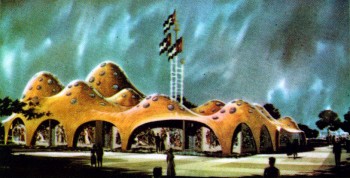 |
The Council's resolution gave some hope
to the officials of the American-Israel Pavilion, but with no
deadline for the mural's removal in sight and mounting protests
by visitors to the Fair and American-Jewish organizations, the
American Jewish Congress (AJC) asked the Fair for permission
to picket in front of Jordan's pavilion on May 25, which would
be the Fair's celebratory "Jordan Day" marking that
nation's independence. Robert Moses refused the AJC's request
succinctly. "We shall not license picketing to encourage
international incidents in a fair primarily devoted to promoting
friendship through increased understanding."108 In a statement to the press, Dr. Joachim
Prinz, the President of the AJC, rejected Moses's ruling. "Mr.
Moses' statement indicates that he regards himself as the sole
judge of whether picketing promotes or hampers international
friendship. In this country, no public official - even one so
eminent as Mr. Moses - has the authority to make such decisions."109 The Committee on American-Arab Relations
(CAAR) might have agreed with Prinz, because the day after Moses's
statement, Dr. Mohammed Mehdi, Secretary General of CAAR telegrammed
Moses asking for permission to picket the American-Israel Pavilion
on May 25 in retaliation to the AJC's request.
We beg permission to picket American-Israeli
Pavilion on May 25th. The existence of this anomalous pavilion,
which is neither American nor Israeli, is both propaganda and
an insult to the Arabs and the Americans. We would not have raised
the issue except for Zionist totalitarianism which is as intolerant
as fascism or communism. Full of hatred against the Arabs, the
Israeli-Americans behaved as if they were in Israel and not in
the midst of an open society. We resent Zionist endeavors to
remove [the] Jordan mural. Freedom of expression must be protected
despite Zionist intolerance.
Moses replied to Dr. Mehdi immediately.
"Let me urge you to drop the matter," he said. "Let's
work for friendship and peace."110
Dr. Prinz did not drop the matter, however,
and on May 25, he and twelve national officers of the AJC defied
the ban on unauthorized demonstrations that the Fair had put
into place because of threatened protests on opening day by civil
rights groups. They were promptly arrested by the Fair's Pinkerton
police force. The offenders were charged with disorderly conduct.
Dr. Mehdi publicly stated that "the fair regulation against
picketing is probably unconstitutional," but he did not
defy the ban. Instead his group demonstrated outside the New
York offices of the AJC and the Anti-Defamation League (ADL),
an organization which had filed a lawsuit in the State Supreme
Court earlier in the week requesting the closing of Jordan's
pavilion. 111
Architectural rendering of the American-Israel
Pavilion, a 45-foot spiral with a facade of African redwood mahogany.*
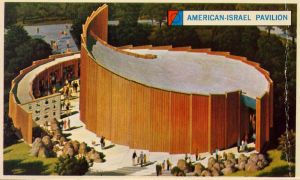 |
(left) Curving steel framework of the Jordan
Pavilion under construction. (right) The American-Israel pavilion
rises from Flushing Meadows in early spring of 1964.*
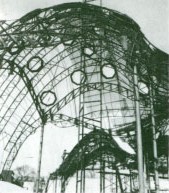 |
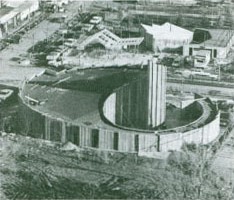 |
Testimony on the ADL's lawsuit began in
early June. For the first time, the World's Fair gave an argument
to back up their position on the mural. Bernard L. Sanoff, lawyer
for the Fair, said that the censorship clause in the Fair by-laws
was "obviously aimed at lewd and lascivious shows."112 The Fair indeed had been censoring some
of the entertainment shows that were not up to quality standards
dictated by Moses or were marked by any possible sexual explicitness.
Moses never denied that he felt censorship necessary for his
good, clean fair. In his opening day essay in the New York
Times, Moses explained the Fair's stance: "Can we survive
without a certain amount of over-the-line vulgarity just short
of censorship and police intervention? We have chosen the side
of the angels."113
Censorship of various pavilions was plentiful
throughout the length of the Fair. On May 9, Charles Poletti
ordered the closing of the French Pavilion because it was "not
French enough," according to the New York Times.114 Before the Fair opened, Moses asked the
Protestant and Orthodox Center not to show its short film "Parable,"
which depicted Jesus in a pantomime's makeup, because he felt
some fairgoers might find it objectionable. The film stayed and
was so popular that it helped in a substantial way to finance
the pavilion.115 A small-budget
rock show called "Summer Time Revue" was also ordered
closed by the Fair in August because Moses thought it was not
in "good taste." In justifying his decision, he said,
"Do you think that we want the church organizations to complain?
The Catholics for example? We invited them here." The producer
maintained that the show had not changed since Moses previewed
it himself, months before.116
Accordingly, the Fair decided censorship was appropriate when
a pavilion did not represent a country properly, when it showed
an exhibit that might offend visitors (especially of the religious
nature), or when it was tasteless. But when censorship was actually
requested for an exhibit that did not represent a country properly,
that did offend many visitors (especially religious ones - thousands
of protest letters were received by the Fair from Jews and Jewish
organizations), and about which many guests and public officials
would argue was tasteless, the Fair did nothing to cease the
complaints.
For Moses to have such strong concerns
about possibly offending the Catholics, it is
surprising that the Fair did not take into any consideration
how offensive the mural was to many Jewish groups and individuals.
According to Robert Caro, Robert Moses's biographer, "Every
one of the major religions in America was represented at the
Fair, save one, and Jewish leaders were increasingly perturbed
by the absence of any representation of their faith (some of
them seeming to feel that the Fair was not especially anxious
to have any)…"117
At the World's Fair there were eight official religious pavilions,
including the Vatican. Five of the religious pavilions, which
were provided rent-free, were placed in the International Area
of the Fair, and thus were under the care of the [Fair's International
Affairs and Exhibits (IAE) division], a staff that consisted
of not one Jew. Moses himself was born to a Jewish family, but
had repeatedly publicly renounced his faith.118 However, Moses's position against the Jewish
and Israel-supporting community at the Fair seemed to be something
other than self-deprecation or anti-Semitism.
The Jewish People did have representation
at the Fair with the American-Israel Pavilion, its major investors
prominent American Jewish organizations such as Hadassah and
the Zionist Organization of America. Originally, the American
Jewish community did plan to erect its own pavilion at the Fair,
with plans spearheaded by the Synagogue Council of America. But
in April 1963, the Council announced it would not be participating
for "practical reasons" that it did not elaborate upon.119 Meanwhile, Israel planned its own pavilion
and had made headway on the design of the building, but the Israeli
Cabinet pulled out of the Fair in October 1962 citing the high
costs of the land lease. Poletti admitted it was a "complete
surprise" and Moses "attacked" Israel's Prime
Minister David Ben Gurion for the withdrawal.120 Moses did not take kindly to nations withdrawing
from his Fair. For example, he was so outraged that Canada was
not participating, that he actually sabotaged the Argentina Pavilion
when he found out its major investor was a Canadian company.
Bruce Nicholson, a member of the IAE division remembers, "It
all seemed like a huge global game, pitting country against country.
We were our own State Department, Defense Department and war
strategists. And if it were necessary to sacrifice Argentina
to spite Canada, so be it."121
Architectural model of the winning design for
the official Israeli Pavilion at
the New York World's Fair. After the Israeli Cabinet rescinded
Israel's official participation in the Fair in 1962, the design
became the basis for their Pavilion at expo67 in Montreal, Canada.
Had the pavilion been built in New York, it would have occupied
the site where the African Pavilion stood.*
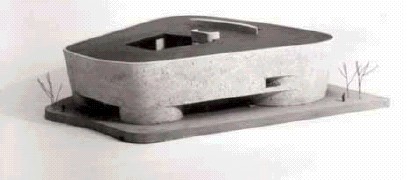 |
Israel was no exception to the wrath of
Moses's personal foreign policy. Despite the success of the quick
mounting of the American-Israel Pavilion, Moses's grudge towards
Israeli and Jewish groups lasted throughout the course of the
Fair.
Besides the mural controversy, there was
one other religious incident at the Fair that outraged local
Jews. In June 1964, a group of 80 students from the Bellerose
Jewish Center visited the Fair's Hall of Education. At this Hall
was an exhibit by the American Board of Missions to the Jews,
Inc., which was established in the 19th Century to "promulgate
the Gospel of the Lord Jesus Christ among the Jews." The
Mission designed its exhibit with the word "Israel"
across the top. On that day, the Baptist minister who ran the
exhibit discreetly lured a 12-year-old boy away from the group
and brought him to the Billy Graham Evangelistic Association
Pavilion to watch the revivalist's film. When the boy's rabbi
and mother made the accusation that this minister attempted to
convert the young boy, the Fair promised to inspect the situation
and if all were true, the exhibit would be closed. However, no
action against the American Board of Missions to the Jews was
ever taken. The Reporter criticized the peddling of religion
at the Fair. "In the midst of the fevered huckstering at
the 1964 New York World's Fair, religion has returned…competing
hard with the other exhibitors in selling a unique product."122 "It is difficult to tell where the
fair begins and religion leaves off," goes an article about
opening day in the New York Times.123 Religion was a prominent exhibit at the
Fair. But now it looked like Moses had religious war on his hands.
On the morning of June 7, when the Commissioner
General of the Jordan Pavilion, Ghaleb Barakat, arrived at work,
he noticed that the Jordanian flag flying atop the pavilion had
been replaced by a blue and white flag reading "American
Israel." The culprit, if found, was never made public, but
the incident prompted Abdul Monem Rifa'I, Ambassador of Jordan
to the UN to write to Francis Plimpton, Deputy Permanent Representative
of the US Mission to the UN in order to "bring the case
to the appropriate authorities." According to Rifa'I, besides
the "hostile activities" of the mural protesters, several
other incidents had occurred, including anonymous bomb threats.
His letter clearly indicts "a certain group of citizens
in New York," the American Jews, as the guilty parties in
the recent occurrences, and with his letter brought the controversy
over the mural into the international realm.124
On June 23 City Council released its resolution
calling for the removal of the mural, "which acts as a daily
and constant irritant and as a source of insult to millions of
people in this City, State, Country and around the world."125 A week prior to this announcement, Dr. Mehdi
met for an hour with the General Welfare Committee (which included
six Jewish members) and said that Jews were offended by the mural
"because of a sense of guilt."126 Dr. Mehdi's visit to Council seemingly caused
more harm than good for his cause, and the adoption of the resolution
passed unanimously.
Adding insult to injury, the American-Israel
Pavilion unveiled a parody to the mural on their site. It included
a blown-up picture of the mural, along with a new poem written
by Chairman Caplin, entitled "Peace Through Understanding".
Part of it reads: "We hail our neighbors here at this fair.
We degrade them not and ask the same in return. And to one and
all, pledge our hope for 'peace through understanding.'"127 The American-Israel Pavilion's new poem
did not cause much of a stir, but Moses sent Lionel Harris, a
member of the IAE who was assigned to the Jordan Pavilion, into
the pavilion to inspect it for offensive items against Jordan.
Harris reported that the entire pavilion was done in good taste
and without hostility.128
The Fair Corporation President was under
a lot of pressure by the June 22 Board of Directors meeting,
as a division began to arise between the Board and Moses over
the issue of the mural. Several members of the Board were hoping
to discuss the controversy at this meeting, although the issue
was deliberately left off the agenda. Congressman Seymour Halpern,
a Board member, thought the issue deserved Board attention, and
submitted a formal request for convoking a special meeting in
early June. In his letter to Robert Moses, Congressman Halpern
wrote:
I do not think that New York
State would have incorporated the Fair nor New York City leased
the site had it been known that this sort of display would be
tolerated. I do not think that the people of New York would have
consented to have the Fair in their midst if they were aware
that it would become a vehicle not for encouraging global harmony
but for perpetuating international conflict.
He cited a by-law stating that when a director
is joined by four fellow members of the Board, they may call
a meeting to act on a matter of importance. Moses got back at
the Congressman, though. "Incidentally you are in error
as to the number of directors who can call a meeting on their
own motion," wrote Moses. "A recent amendment to the
By-Laws requires 50 directors to initiate such a meeting."129
A very prominent member of the Board of
Directors, New York Senator Kenneth B. Keating spoke at the dedication
of the American-Israel Pavilion on "American Israeli Day"
at the Fair, May 24, against Moses's will. In a letter to Keating's
office, Moses said of the upcoming speech, "I strongly urge
him not to rock the boat."130
At the dedication, Keating did not mention the Jordan Pavilion
specifically, but spoke highly of the American-Israel Pavilion
as one that "contrasts strongly with those who seek to hide
the truth and obscure the realities of the Middle East."131
House of Representatives Chairman of the
Committee on the Judiciary, Emanuel Celler was one of the first
Directors to seek answers from Moses. In a letter from May, Congressman
Celler wrote, "Were I to draw an analogy of a Soviet Union
Pavilion on our fairgrounds bearing a message addressed to the
Western World, 'We will bury you,' would you not agree that such
statement of hostility would be out of place?...Even in the mildest
of terms, such murals are, we must concede, offensive to the
canons of good taste…" [Empahsis added]
State Senator Joseph Zaretzki, the minority
leader, drafted a resolution to force the Jordan Pavilion to
remove the inscription from the mural, which he tried to get
on the Board agenda for June 22. Moses wouldn't allow it. At
the meeting, the opposition to Moses came to a head. Liberal
Party Vice-Chairman Alex Rose, who authored his own resolution
urging the Fair to change its neutrality policy on the mural
issue, was "gaveled down" by Moses when he tried to
introduce his resolution. Moses ruled that due to the pending
litigation in the courts by the ADL, the Board was in no position
to discuss the matter. The Board erupted into shouts and gavel-pounding,
and Senator Javits asked for a vote on the whether the debate
should be closed or not. When Moses got his way 59 to 24, Senator
Zaretzki brought up his resolution again. Moses ignored Senator
Zaretzki, and began talking over him with other business until
finally Zaretzki relented.132
The next day, Alex Rose publicly announced
his resignation from the board. He argued that the mural was
"sheer war propaganda" being presented to "unsuspecting
viewers." "Little do they know," the letter said,
"that instead of peace through understanding they are getting
war through misunderstanding."133 Then Senator Zaretzki, in a television interview,
called Moses a "despot", referred to him as "Boss
Moses" and labeled the Board of Directors a "useless
body."134
The Fair never officially commented on
the Board proceedings and the resignation of Alex Rose, nor did
it enforce the City Council resolution to remove the mural. The
Fair issued a statement against the resolution, arguing that
the Council was asking for the "suppression of free speech."
The statement went on to say that the Fair has "no power"
to order the removal of the mural.
Moses's arguments, however, were losing
footing with all of the negative publicity about the Board of
Directors meeting, the City Council resolution, and the lawsuits
pending in State Supreme Court. On July 9, Moses gained a small
victory when Justice George Postel dismissed the lawsuits against
the Fair. His decision was based on the technicalities of the
lease between the Fair Corporation and the City of New York,
which did not give any rights to the city for the regulation
of exhibits. This ruling nullified the City Council resolution.
Additionally, according to the New York Times, Justice
Postel also "rejected the fair's contention that a constitutional
issue of censorship of a political message was involved."
The judge admittedly sympathized with the plaintiffs, and regretted
that "those in a position to cure or alleviate the sore
are unable or unwilling to do so." Moses, triumphant, approved
of the decision, which "fully upholds the position we have
taken, which was based on principle."135 Just what principle that was, Moses never
made clear.
Hostile Neighbors:
The curving roof line of the Jordan pavilion (center) can clearly
be seen in this view of the Fairgrounds from the Skyride . In
the near-distance, behind the Jordan pavilion, can be seen the
mahogany spiral with yellow roof of the American-Israel Pavilion.*
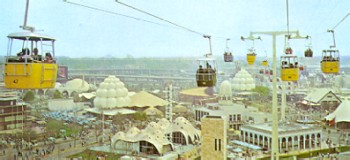 |
Robert Moses had another reason to be happy
during July of 1964. It was then that he,
Charles Poletti, and Lionel Harris were notified that they would
be receiving the Al-Kokab, the Star of Jordan, First Class. The
award they were to receive was the highest honor that the King
of Jordan could bestow upon anyone. Harris reported to Poletti
that the Jordan Consul in Washington "stressed the fact
that…while the Jordanians are deeply grateful for our stand
in the matter of the mural and for all our help in general, he
wants us to understand that the award is an overall token of
esteem, and is not directly tied to the mural controversy."136 But Moses reflected several years later
in an article, that "Jordan and Arab states were so astonished
by the nonpolitical conduct of the fair heads," that he
and the others received that award "for our contribution
to understanding and friendship of nations at the World's Fair."137
These Fair administrators had a long and
comfortable relationship with Jordan and its
King since early Fair planning stages. Jordan was the first Arab
state to accept the Fair's invitation, on March 2, 1961. Moses
visited Amman with a Fair delegation, and King Hussein likewise
visited the Fair once before it opened, and also on April 23,
1964 when a luncheon in his honor was held at the Terrace Club
at the Fair. (No head of Israel ever visited the Fair, though
Levi Eshkol, Prime Minister canceled a scheduled visit for June
11 in protest of the mural.) 138
Moses had taken a particular interest in
Jordan because of his experience as an urban planner. He had
theories about water conservation, energy opportunities on the
Jordan River, housing for refugees, and city development. Moses
felt that his experience as a planner in New York City was enough
for him to make judgments on the economic and political situation
in Jordan, and with the start of his relationship with King Hussein,
he really began to indulge in his theories. Long after the Fair,
Moses continued coming up with plans for Jordan and tried to
put together a committee to study development opportunities there.
In 1971, Moses wrote an op-ed for the New York Times entitled
"Harness the Jordan." In this piece, Moses urged the
United States to take interest in Jordan for "multipurpose,
regional power and reclamation and pave the way for industrial
progress." (Moses discussed the mural controversy in this
editorial by claiming that "fanatics" brought the case
to court "to stir up trouble within the fair, in the city
administration, among political leaders sensitive to racial and
religious issues and among professional religionists.")
In a 1977 letter Moses wrote to WNET Channel 13 in hopes of receiving
its support for a committee on Jordan, he said
This problem is for engineers,
not diplomats and politicians…With my Fair and engineering
associates I became interested in a scientific engineering of
the Jordan, Jordan River, Israel and the PLO dispute. It occurred
to some of us that the King of Jordan might take the PLO into
Jordan as a state within his nation based on sound, constructive
engineering principals.
While Moses never got a committee of his
sort to come about, it seemed that the Fair inspired him to think
internationally about his once local positions. After the Fair,
Moses went on to consult on urban planning issues all over the
world.139
Moses's biographer, Robert Caro, had a
different opinion about Moses's expansion of
scope. His poor relations with Israel after their official pavilion
withdrew hurt Moses's Public image in the world outside New York.
"The Fair destroyed Moses' reputation…because he had
to have his own way about everything, even in a field in which
he was the newest of newcomers. He could have his own way in
New York, but in putting on a World's Fair, he had to deal with
other states and countries - and his arrogance antagonized them."140 Caro is not entirely correct regarding Moses
and Israel. The mural issue was subdued in the Israeli press,
and the major papers Ha'Aretz and Ha'Doar actually
stressed that the complaints over the mural were giving the Jordan
Pavilion extra publicity. Nearly all of the chastising towards
Moses came from the local Yiddish Press and from American Jewish
organizations.
But it was the antagonism of the people
in his own country and city that gave Moses immediate concerns
to deal with. The NAACP and CORE sued the fair for the right
to hold protests, since many of their members had been arrested
at the start of the Fair for organized "stall-ins"
that were staged to attract attention to the Civil Rights movement
in the US. Between Civil Rights protesters and mural protesters,
the Queens Criminal Court had 200 cases by mid-June 1964. Judge
Harold R. Tyler of the Federal Court ruled on July 1 that Fair
protesters did have the right to distribute handbills, although
not to picket in a way that would block roadways or paths. Since
the twelve AJC picketers did not cause a disturbance in May,
Judge Dubin of the Queens Criminal Court acquitted them all on
July 29. In addition, he stressed that their right to picket
in a public space was guaranteed under the First Amendment, since
in 1963 the Legislature ruled that the Fair, a private corporation,
was to be considered public property. Judge Dubin's ruling was
a victory for the AJC, which was countersuing the Fair for the
right to picket under the First Amendment. That suit was finally
settled in April of 1965 in the State Supreme Court, just in
time for the start of the 1965 season. The Fair agreed that the
AJC could assign two members to distribute handbills from designated
spots outside the Jordan Pavilion, a concession that the Fair
could have easily made a year before to avoid the drama that
instead took place.141
Sympathizers with the Jordan Pavilion were
not pleased with the course of events. Dr. Mehdi again wrote
to Moses asking for permission for CAAR members to picket the
American-Israel Pavilion, as well as "the two people distributing
leaflets" at the Jordan Pavilion. Before receiving this
permission, CAAR sent two members to hand out leaflets in front
of the American-Israel Pavilion which said "Don't buy Israel
bonds, buy U.S. bonds." On April 30, some of the entertainers
from the American-Israel Pavilion began to taunt them, and a
fistfight broke out. Zechariahu Sitchin, President of the American-Israel
Pavilion, expressed his disappointment that the fairgrounds should
be turned into a "battleground."142
Workers at the American-Israel Pavilion
continued to provoke the CAAR picketers, when on May 1 they arranged
a lunch table for them near the entrance to the pavilion. "On
the table were six bologna sandwiches and four bottles of Israeli
beer," reported the New York Times. "Also on
the table was a large sign saying: 'For your misguided pickets
- kosher food, compliments of the American-Israel Pavilion.'"
-
The invitation to participate
in the World's Fair was presented to the Prime Minister of Israel
in January, 1961, by the World's Fair delegation to the Near
East. Israel selected a site facing the main mall of the Fair.
-
(from left to right) Governor Charles
Poletti; His Excellency David Ben Gurion, Premier of Israel;
Dr. K. C. Li
-
-
Israel withdrew their official
participation in the Fair in 1962.*
 |
Beyond those few incidents, picketing,
and the controversy itself, surprisingly seemed
to fade from protesters' and the public's mind during the 1965
Fair season. Like nothing ever happened, the mural with its inscription
remained. The only apparent effect of the controversial events
was the slight deterrent of American Jews and Jewish organizations
to attend the Fair. Some Rabbis opted to persuade their congregants
to boycott the Fair, although the number of Jews who actually
boycotted is unknown and thought to be rather slim. On the issue
of censorship at the Fair, the situation also had little effect.
The Fair continued to censor objectionable exhibits during and
after the mural controversy. The only thing ever removed from
the Jordan Pavilion, though, was an "unauthorized vending
machine" in 1965.143
© Copyright 2005 Sharyn Elise Jackson, All Rights
Reserved.
|